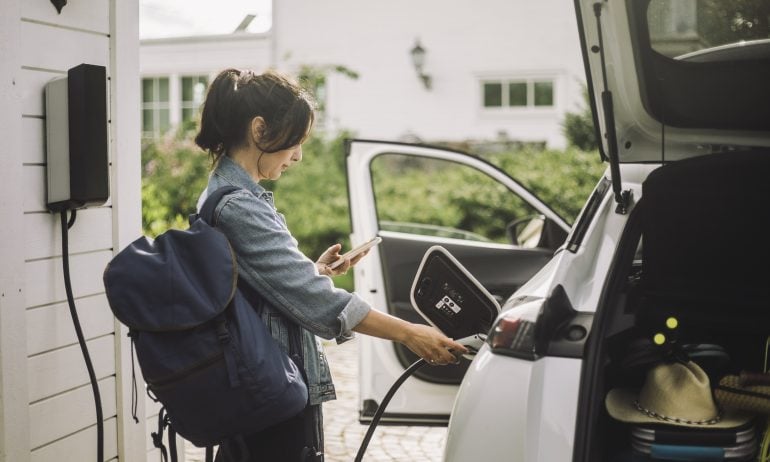How Long Does It Take to Charge an Electric Car?
Charging an EV can take a half hour — or more than a day — depending on the type of vehicle and charger you use.

Many, or all, of the products featured on this page are from our advertising partners who compensate us when you take certain actions on our website or click to take an action on their website. However, this does not influence our evaluations. Our opinions are our own. Here is a list of our partners and here's how we make money.
You could add 200 miles of range to an electric vehicle in 30 minutes or less using the fastest available commercial charger, a DC fast charger. At the other extreme, only about five miles will trickle into your EV’s battery during the same amount of time if you use a charger that plugs into a standard outlet.
Other factors can affect charging speed, including battery size (capacity), how empty the battery is, battery age and the temperature outside, but the type of charging connection is the main factor in how quickly your battery charges.
Electric vehicles and charging equipment
Level 1 | Level 2 | Level 3/DC fast charging | |
|---|---|---|---|
Range added per hour of charging (approximate) | 5 miles. | 25 miles. | 180-240 miles or more. |
Available for in-home use? | Yes. The charging hardware comes standard with nearly every new EV. | Yes, but you’ll need to buy additional equipment and potentially hire an electrician to install a 240-volt outlet. | No. Available at public charging stations, but home installation isn’t feasible due to cost and power requirements. |
When this type of charger works well at home | If you drive fewer than 40 miles each day, using a Level 1 charger at home could work well. If you occasionally need a quicker charge, use a public charger. | If you typically drive more than 40 miles per day — or value convenience of not visiting public charging stations — you might want a Level 2 home charger. | N/A. |
Available on the road? | Typically not available at public charging stations. | Yes. Most public chargers are Level 2. Sometimes located where you park your car for a while, like a workplace or a parking garage. | Yes. Usually found on corridors where people want to charge quickly and keep driving, like an interstate. |
Charger type | J1772. | J1772 or Tesla. | CCS, CHAdeMO, or Tesla. |
Level 1 charging: slow, but easy

(Photo courtesy of Getty Images)
A Level 1 EV charger plugs directly into a standard 120-volt wall outlet. This type of charger connects to your car via hardware called a connector, which resembles a gas pump with a stubby nozzle. On the end is a circular plug that has five smaller circular connection points. This universal connection, called J1772, is compatible with nearly every EV in the U.S. Think of it as a more advanced version of the standard plug that’s found on items like lamps and vacuums.
Level 1 is the slowest type of EV charging. Charging overnight might add 40 or 50 miles of range. According to the Federal Highway Administration, the average person drives about 40 miles a day, so even Level 1 charging may be sufficient for the average person’s daily driving needs.
Even if you decide to upgrade to Level 2, there’s a place for Level 1 charging. It’s not fast, but its compatibility with regular outlets makes it a good thing to have, in case of an emergency.
» MORE: Should I buy an EV?
Level 2 charging: faster, but requires extra hardware
A Level 2 EV charger connects to your car with the same J1772 connector as in Level 1 charging — unless your car is a Tesla. Tesla uses its own connector instead of J1772, but the same connector is still used for Level 1 and Level 2 charging. What differs is the hardware on the other end of the cable. Level 2 charging draws electricity from a more powerful source, tapping into a 240-volt connection on a dedicated 40-amp circuit. That extra power means a faster charge: about 25 miles or more in an hour.
That amount of power in a home is usually reserved for large appliances, like an electric clothes dryer or oven. The outlet this type of connection uses looks different from a standard wall outlet. A 240-volt connection isn't found in most garages — though it might soon become the norm for new builds — so if you want a Level 2 charger where you park your car, you’ll need an electrician to install one. Because Level 2 charging hardware is nearly universal, you can shop around for the best price. Between wiring and equipment, installing this type of charger at your home can cost a few thousand dollars.
About 3 in 4 public chargers are Level 2 connections. Because it might take an hour or two to charge up, these chargers are often found in settings where you leave your car parked for that amount of time — at a mall, in an office complex or in a parking garage, for example. There are more than 58,000 public charging locations with Level 2 chargers available in the U.S.
Explore the auto-buying platforms from our partners below.
AD
Level 3/DC fast charging: fastest, but not needed for everyday use
The fastest charging speeds are on Level 3 EV chargers, also called DC fast charging, or DCFC. You can add hundreds of miles of range in as little as 30 minutes.
You’ll only find these chargers at commercial charging stations due to the high-power connections.
Level 3 connectors come in three configurations:

CCS charger, CHAdeMO charger, Tesla charger (Photo courtesy of Getty Images)
CCS connector. This looks like a standard connector with an additional plug beneath it. Most newer EVs sold in the U.S. are CCS compatible.
CHAdeMO connector. While less popular in the U.S. than CCS, some cars, including the Nissan Leaf, use it.
A Tesla connector. Tesla has its own charger, which also works for Levels 2 and 3.
Most plug-in hybrid electric vehicles — those with a battery that can be charged via a plug or an internal combustion engine — don’t work with a Level 3 charger.
Over time, heavy use of DC charging can degrade battery health. Using Level 1 or Level 2 charging as your default method, and reserving DC charging for longer trips, is one way to prolong an EV battery’s life.
Tesla Supercharger network
Tesla operates its own fast-charging network, with Level 3 chargers called Superchargers. Depending on the Tesla model, a Supercharger can add up to 200 miles of range in 15 minutes.
With more than 2,300 locations, Tesla’s Supercharger network has an extensive U.S. footprint. Historically, only Tesla drivers could use Tesla's chargers, in part due to its unique charging hardware, but that is gradually changing. In 2024 Tesla opened its chargers to drivers of other EV brands, and some other carmakers are providing adapters to use Tesla charging for their vehicles.
Tesla drivers can also use what are called Tesla Destination Chargers — Level 2 chargers owned and operated by the businesses where they’re located, such as hotel parking lots. Non-Tesla public charging stations can be used by Tesla owners, but the Tesla owner may need to provide their own adapter.

Many factors affect EV battery charging speed
The amount of time it takes to charge your EV battery will vary from time to time, depending on many different factors. While the type of charger and charging station you use has the biggest impact, here are some other factors that come into play.
EV battery size. EV battery sizes vary, and bigger batteries take longer to fully charge. Some EV models even offer the option to select a battery size. The tradeoff for having a larger battery that takes longer to fully charge is the capacity to add more range from a single charge. Because of this, it’s useful to think about charging in terms of how much range is added rather than time to charge from empty to 100%.
EV maximum charging speed. EVs have electricity voltage and current limits that vary. For example, an EV may only have the capability of receiving up to 270 kW of electricity from a charging station, even if the station's output is 350 kW. Also, while EV batteries last many years, they can lose some capacity and charging speed over time.
Battery state of charge. This means how full your battery already is while you’re charging. Most EV makers recommend maintaining a battery charge at 20%-80% to promote battery health, so EV batteries will typically charge faster when already within that range. If you’re charging beyond 80%, the speed of charging will usually slow down to protect the battery.
Temperature when charging. EV batteries perform best and last longer within a certain temperature range, and most EVs have what’s called a thermal management system to protect batteries from extreme heat and cold. If it’s very hot or cold outside, this system may slow charging speeds to keep the battery at an optimal temperature.





